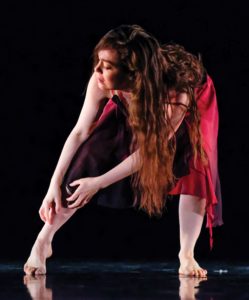Winnipeg: Fall 2019 - Vancouver Ballet Society
- Home
- City Reports 2015 - 2019
- Winnipeg: Fall 2019

by Holly Harris
Q Dance’s latest mixed bill was its first comprised exclusively of world premieres, all choreographed by artistic director Peter Quanz. The Ontario-born dance artist is continuing to carve out his career in Canada as well as China, where he has worked extensively for the last five years. In August, Wuxi Song and Dance Theatre premiered his full-length ballet Lost in Wuxi, China, and will tour the production across Canada and the U.S. this October. Quanz returns to China for two months in November to create a work for Harbin Ballet.
Back home in June, the four-performance run of premieres at Winnipeg’s intimate Gas Station Arts Centre featured an expanded company, including returning Royal Winnipeg Ballet members Liam Caines, Philippe-Alexandre Jacques, Alanna McAdie and Yosuke Mino, joined by newly retired RWB principal Jo-Ann Sundermeier and soloist Josh Reynolds. The 55-minute show also featured contemporary dancer Kathleen Hiley, creating a fascinating mélange of classical-meets-contemporary choreographic styles.
One of Quanz’s most compelling pas de deux, Wistful, set to Rachmaninoff’s Vocalise, Op. 34. No. 14, became a searing parting gift for Sundermeier (one of QD’s founding members) and Reynolds. The American husband-and-wife team returned to the U.S. immediately following the run to raise their daughter, Ayla, closer to family in New Orleans, as well as to join New Orleans Ballet Theatre.
The seven-minute duet performed in soft ballet slippers ranged from tender embraces and enthralling lifts, to tension-filled pushes and pulls away from each other that infused the work with vulnerability, becoming a testament to intimate human relationships. It showcased Sundermeier’s pristine classical technique, pliable spine and spot-on musicality, with a final ecstatic image of the ballerina held aloft by her partner, her graceful arms arching like tree limbs into the darkness.
The program opened with ensemble piece Sprezzatura — translated from Italian as “studied carelessness” — set to a pastiche Baroque score, with six dancers, dressed in checkerboard jumpsuits and black-and-white slippers, leaping and spinning in a joyous combustion of kinetic movement.
Quanz interweaves a series of solos and smaller ensembles into his geometrical patterning, spotlighting his dancers’ unique strengths and personalities: McAdie’s intricate footwork, hops, skips, floor slides and quicksilver shifts of direction; Mino’s bounding leaps that pop like a champagne cork and his palpable joy performing with his real-life partner McAdie; and Sundermeier and Reynolds’ simpatico artistry manifested in suspended lifts and molten partnering, grounded in Quanz’s signature “wiggles.” A male pas de trois highlighted the rugged athleticism of Jacques, Caines and Reynolds, juxtaposed with sculptural poses evoking the choreographer’s 2011 Rodin/Claudel for Les Grands Ballets Canadiens de Montréal. The dancers embodied the score’s tightly knit polyphonic lines as music made visible.
The final offering, Musings, inspired by solo accordion and double bass recordings Quanz discovered in a vintage CD shop, is structured primarily as two solos for Hiley, dressed in a blood-red dress, augmented by ensembles featuring Caines, Jacques and Mino, in pedestrian dark trousers and white shirts. Musings showcased the dramatic sensibility of the barefooted Hiley, who performed Quanz’s contemporary dance vernacular, including body isolations, gnarly hands that twist like Spanish floreo, wide sweeps across the stage, percussive kicks and tumbleweed rolls, with the passion of a woman possessed. Seeing the three ballet dancers merge with the modern artist for their final quartet was icing on the cake.
Special mention goes to Caines and Jacques’ powerhouse pas de deux, taut with tension, with each dancer taking turns carrying the other on their back while crawling on all fours. This section’s dark imagery, in which they push and heave their chests, became difficult to watch, however, and the entire work felt disjointed, despite some levity and emotional counterbalance provided by the men bounding about the stage like frantic Keystone Cops.
Earlier at the Gas Station Arts Centre, Gearshifting Performance Works wrapped up its season with the premiere of Schemas 1-5, choreographed by founding artistic director Jolene Bailie, who begins her appointment as artistic director of Winnipeg’s Contemporary Dancers this fall.
The 55-minute show was performed to a collage score unfolding as a series of five “schemas” stamped with Bailie’s trademark humour and ability to craft graphic visuals both bold and beautiful, as witnessed in her 2013 Hybrid Human. She has continued to mine those images with her latest creation, in many ways the flipside to Hybrid Human, in which the earlier dancers dressed in black body stockings and masks now appear in beige leotards, heightening the sense of witnessing living sculpture.
The show was most potent with its imagery of dancers covered in fluttering rose petals, or a rustling white tarp cast over the stage suggesting clouds, a snowy landscape or a burial shroud. However, its poeticism begins to devolve as larger ensembles break into smaller quartets, trios and duos that deflate the energy. And its decidedly absurd Last schema, with dancers yelling to punctuate stacks of falling dinner plates, felt obtuse and left this viewer stumped.

Photo: Daniel Crump
